Wound Care Prevention: Stages, Management, and Treatment Approaches
VerifiedAdded on 2022/08/12
|8
|2140
|21
Report
AI Summary
This report provides a comprehensive overview of wound care prevention, differentiating between open and closed wounds, and emphasizing the importance of proper wound care for faster healing. It details various factors contributing to wound development, including health conditions, injuries, and lifestyle choices. The report outlines preventive measures like avoiding sharp objects, maintaining good hygiene, and managing underlying health issues. It then delves into the stages of wound care prevention, such as maintaining skin integrity, managing pain, and addressing exudate, infection, and odor. The report also discusses the importance of proper wound dressing, nutrition, and debridement techniques. The use of various assessment tools for pain and the role of both curative and palliative care objectives are also highlighted, offering a detailed guide to effective wound management practices. The report is well-researched, with a focus on practical strategies and evidence-based approaches to promote optimal patient outcomes.
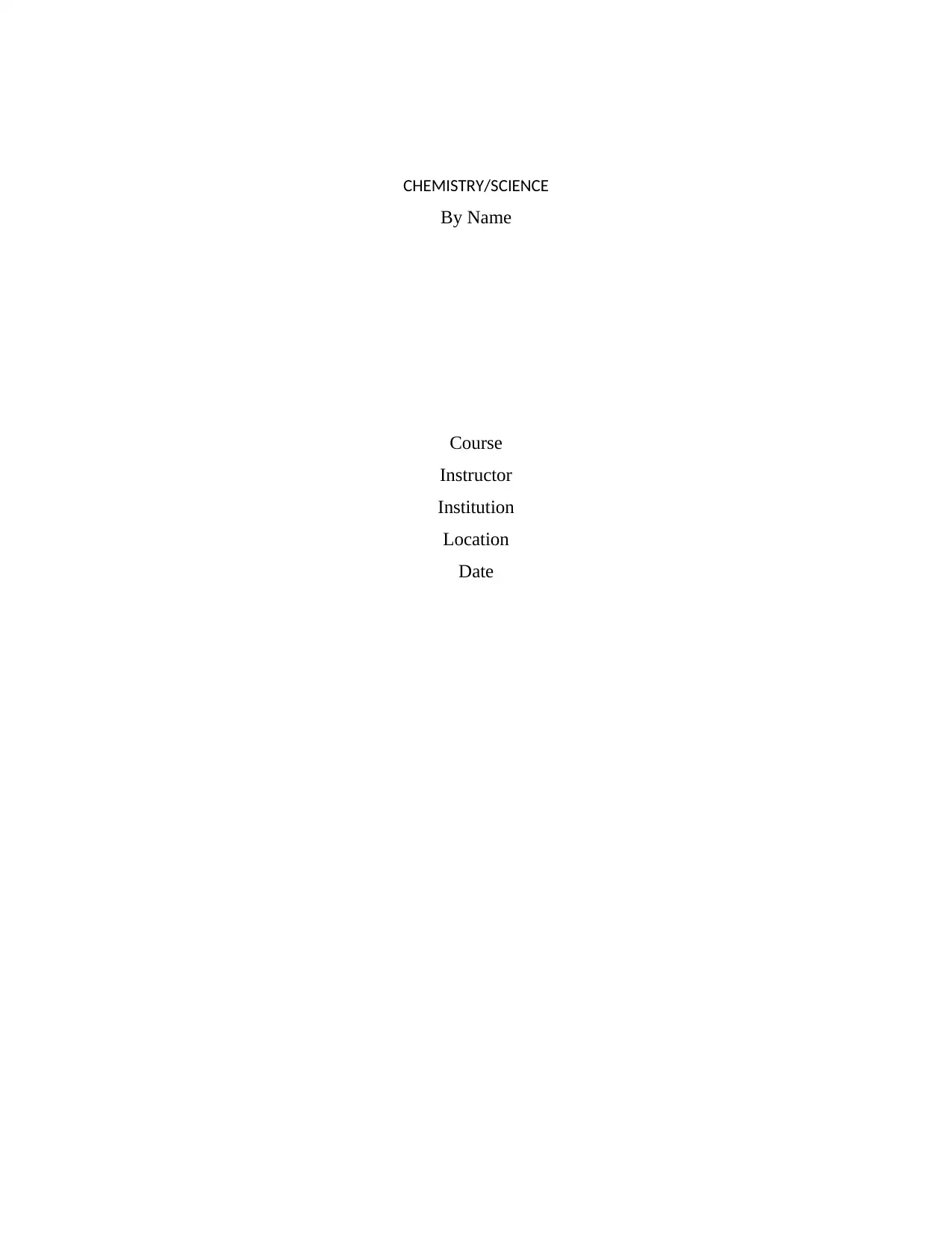
CHEMISTRY/SCIENCE
By Name
Course
Instructor
Institution
Location
Date
By Name
Course
Instructor
Institution
Location
Date
Paraphrase This Document
Need a fresh take? Get an instant paraphrase of this document with our AI Paraphraser
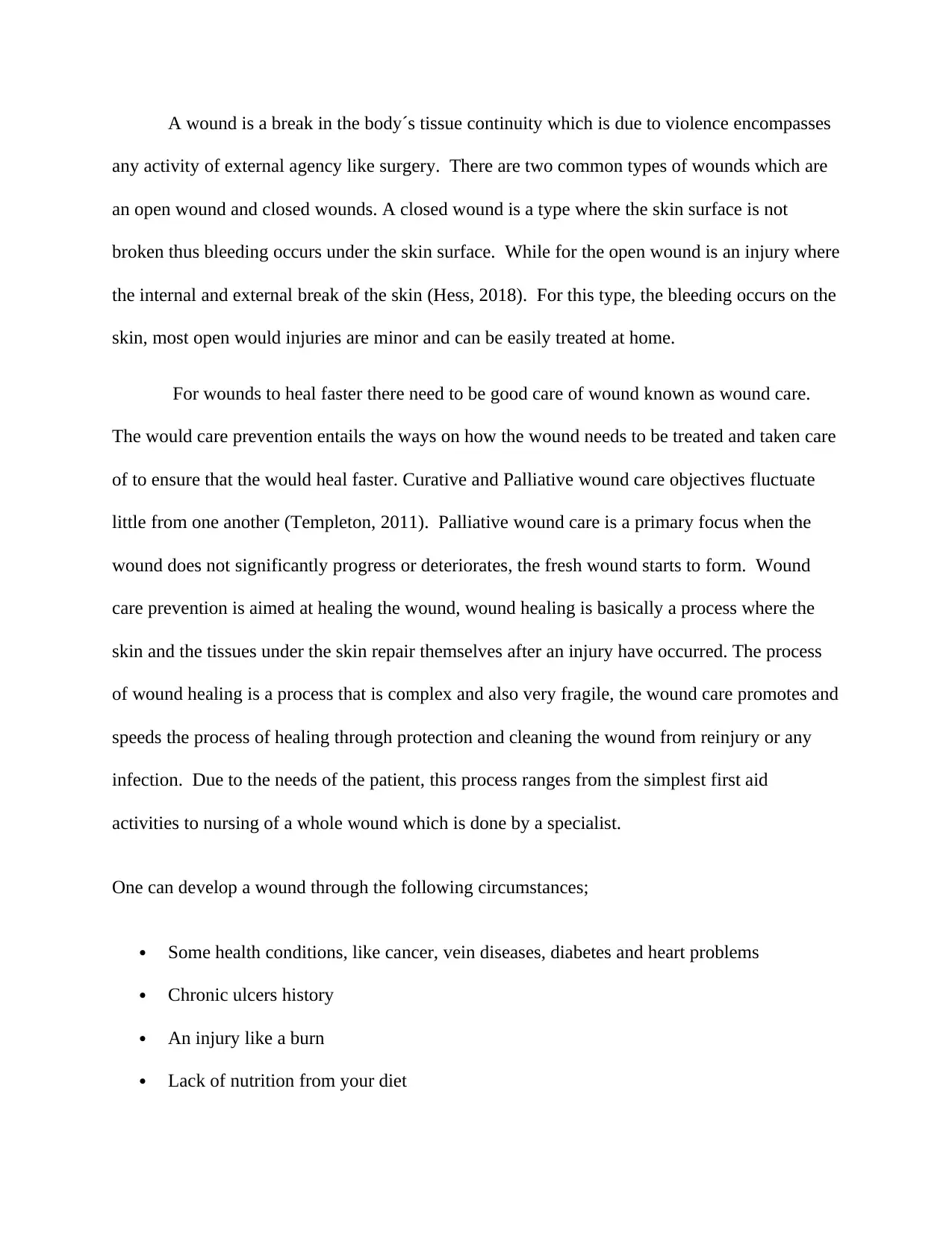
A wound is a break in the body´s tissue continuity which is due to violence encompasses
any activity of external agency like surgery. There are two common types of wounds which are
an open wound and closed wounds. A closed wound is a type where the skin surface is not
broken thus bleeding occurs under the skin surface. While for the open wound is an injury where
the internal and external break of the skin (Hess, 2018). For this type, the bleeding occurs on the
skin, most open would injuries are minor and can be easily treated at home.
For wounds to heal faster there need to be good care of wound known as wound care.
The would care prevention entails the ways on how the wound needs to be treated and taken care
of to ensure that the would heal faster. Curative and Palliative wound care objectives fluctuate
little from one another (Templeton, 2011). Palliative wound care is a primary focus when the
wound does not significantly progress or deteriorates, the fresh wound starts to form. Wound
care prevention is aimed at healing the wound, wound healing is basically a process where the
skin and the tissues under the skin repair themselves after an injury have occurred. The process
of wound healing is a process that is complex and also very fragile, the wound care promotes and
speeds the process of healing through protection and cleaning the wound from reinjury or any
infection. Due to the needs of the patient, this process ranges from the simplest first aid
activities to nursing of a whole wound which is done by a specialist.
One can develop a wound through the following circumstances;
Some health conditions, like cancer, vein diseases, diabetes and heart problems
Chronic ulcers history
An injury like a burn
Lack of nutrition from your diet
any activity of external agency like surgery. There are two common types of wounds which are
an open wound and closed wounds. A closed wound is a type where the skin surface is not
broken thus bleeding occurs under the skin surface. While for the open wound is an injury where
the internal and external break of the skin (Hess, 2018). For this type, the bleeding occurs on the
skin, most open would injuries are minor and can be easily treated at home.
For wounds to heal faster there need to be good care of wound known as wound care.
The would care prevention entails the ways on how the wound needs to be treated and taken care
of to ensure that the would heal faster. Curative and Palliative wound care objectives fluctuate
little from one another (Templeton, 2011). Palliative wound care is a primary focus when the
wound does not significantly progress or deteriorates, the fresh wound starts to form. Wound
care prevention is aimed at healing the wound, wound healing is basically a process where the
skin and the tissues under the skin repair themselves after an injury have occurred. The process
of wound healing is a process that is complex and also very fragile, the wound care promotes and
speeds the process of healing through protection and cleaning the wound from reinjury or any
infection. Due to the needs of the patient, this process ranges from the simplest first aid
activities to nursing of a whole wound which is done by a specialist.
One can develop a wound through the following circumstances;
Some health conditions, like cancer, vein diseases, diabetes and heart problems
Chronic ulcers history
An injury like a burn
Lack of nutrition from your diet
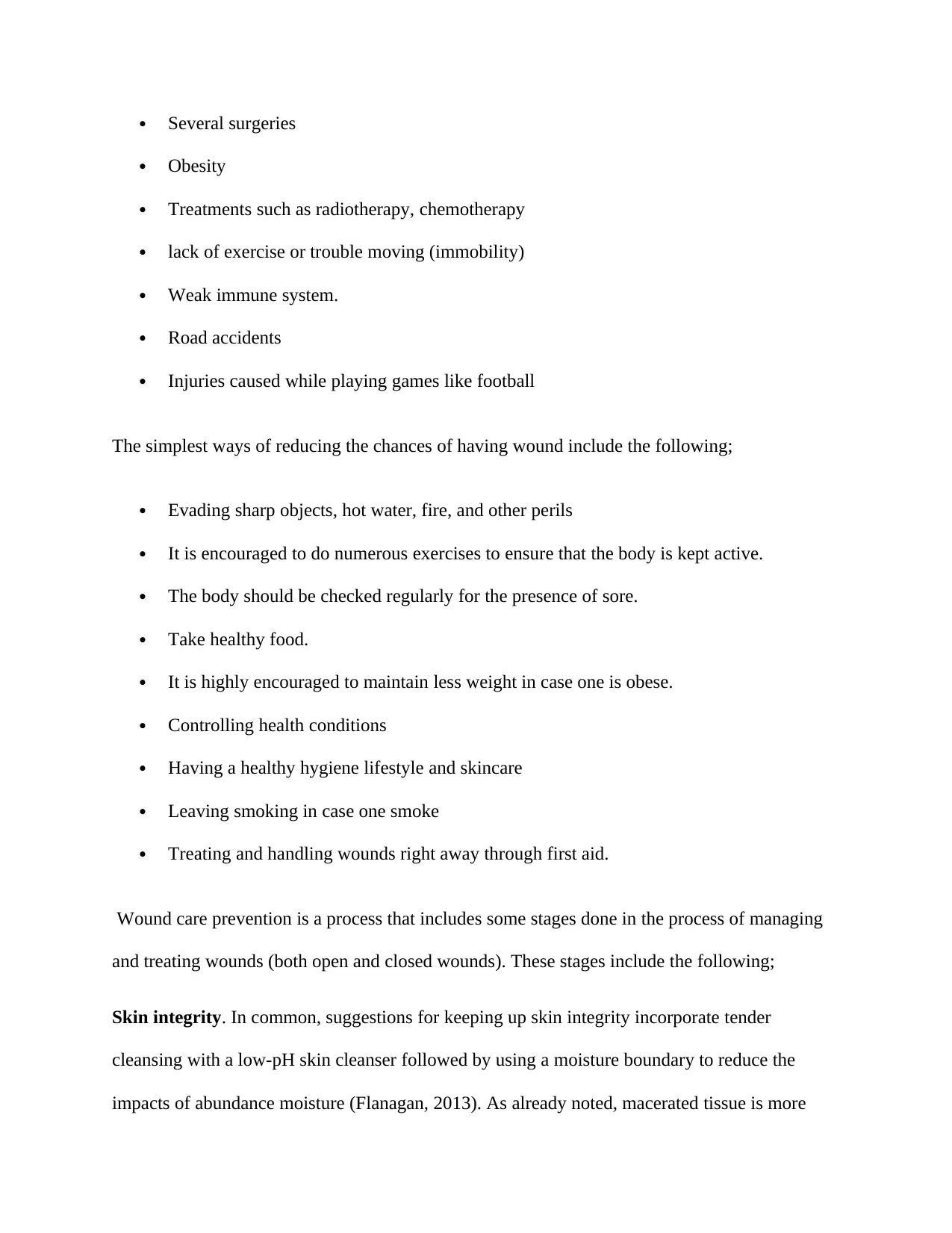
Several surgeries
Obesity
Treatments such as radiotherapy, chemotherapy
lack of exercise or trouble moving (immobility)
Weak immune system.
Road accidents
Injuries caused while playing games like football
The simplest ways of reducing the chances of having wound include the following;
Evading sharp objects, hot water, fire, and other perils
It is encouraged to do numerous exercises to ensure that the body is kept active.
The body should be checked regularly for the presence of sore.
Take healthy food.
It is highly encouraged to maintain less weight in case one is obese.
Controlling health conditions
Having a healthy hygiene lifestyle and skincare
Leaving smoking in case one smoke
Treating and handling wounds right away through first aid.
Wound care prevention is a process that includes some stages done in the process of managing
and treating wounds (both open and closed wounds). These stages include the following;
Skin integrity. In common, suggestions for keeping up skin integrity incorporate tender
cleansing with a low-pH skin cleanser followed by using a moisture boundary to reduce the
impacts of abundance moisture (Flanagan, 2013). As already noted, macerated tissue is more
Obesity
Treatments such as radiotherapy, chemotherapy
lack of exercise or trouble moving (immobility)
Weak immune system.
Road accidents
Injuries caused while playing games like football
The simplest ways of reducing the chances of having wound include the following;
Evading sharp objects, hot water, fire, and other perils
It is encouraged to do numerous exercises to ensure that the body is kept active.
The body should be checked regularly for the presence of sore.
Take healthy food.
It is highly encouraged to maintain less weight in case one is obese.
Controlling health conditions
Having a healthy hygiene lifestyle and skincare
Leaving smoking in case one smoke
Treating and handling wounds right away through first aid.
Wound care prevention is a process that includes some stages done in the process of managing
and treating wounds (both open and closed wounds). These stages include the following;
Skin integrity. In common, suggestions for keeping up skin integrity incorporate tender
cleansing with a low-pH skin cleanser followed by using a moisture boundary to reduce the
impacts of abundance moisture (Flanagan, 2013). As already noted, macerated tissue is more
⊘ This is a preview!⊘
Do you want full access?
Subscribe today to unlock all pages.

Trusted by 1+ million students worldwide
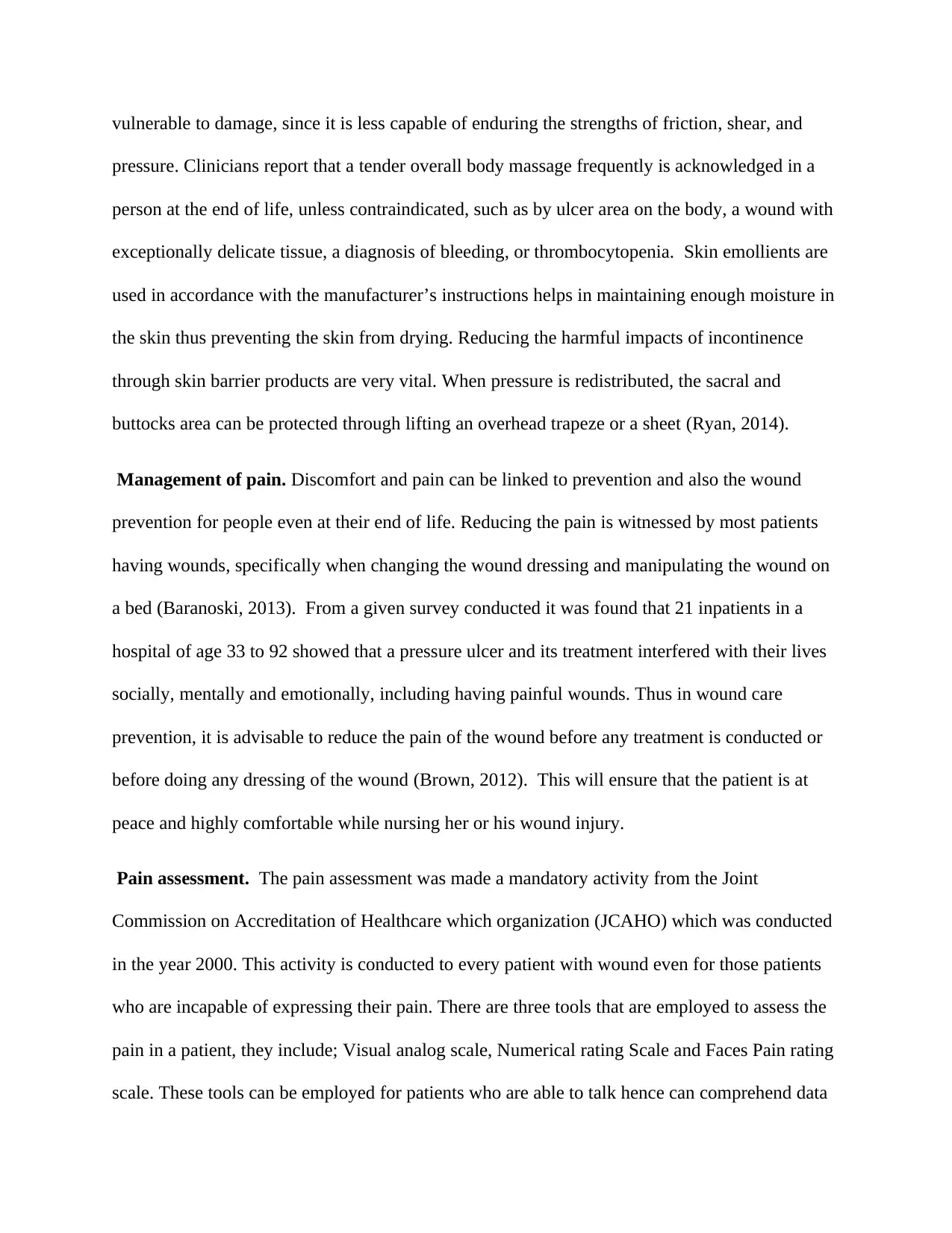
vulnerable to damage, since it is less capable of enduring the strengths of friction, shear, and
pressure. Clinicians report that a tender overall body massage frequently is acknowledged in a
person at the end of life, unless contraindicated, such as by ulcer area on the body, a wound with
exceptionally delicate tissue, a diagnosis of bleeding, or thrombocytopenia. Skin emollients are
used in accordance with the manufacturer’s instructions helps in maintaining enough moisture in
the skin thus preventing the skin from drying. Reducing the harmful impacts of incontinence
through skin barrier products are very vital. When pressure is redistributed, the sacral and
buttocks area can be protected through lifting an overhead trapeze or a sheet (Ryan, 2014).
Management of pain. Discomfort and pain can be linked to prevention and also the wound
prevention for people even at their end of life. Reducing the pain is witnessed by most patients
having wounds, specifically when changing the wound dressing and manipulating the wound on
a bed (Baranoski, 2013). From a given survey conducted it was found that 21 inpatients in a
hospital of age 33 to 92 showed that a pressure ulcer and its treatment interfered with their lives
socially, mentally and emotionally, including having painful wounds. Thus in wound care
prevention, it is advisable to reduce the pain of the wound before any treatment is conducted or
before doing any dressing of the wound (Brown, 2012). This will ensure that the patient is at
peace and highly comfortable while nursing her or his wound injury.
Pain assessment. The pain assessment was made a mandatory activity from the Joint
Commission on Accreditation of Healthcare which organization (JCAHO) which was conducted
in the year 2000. This activity is conducted to every patient with wound even for those patients
who are incapable of expressing their pain. There are three tools that are employed to assess the
pain in a patient, they include; Visual analog scale, Numerical rating Scale and Faces Pain rating
scale. These tools can be employed for patients who are able to talk hence can comprehend data
pressure. Clinicians report that a tender overall body massage frequently is acknowledged in a
person at the end of life, unless contraindicated, such as by ulcer area on the body, a wound with
exceptionally delicate tissue, a diagnosis of bleeding, or thrombocytopenia. Skin emollients are
used in accordance with the manufacturer’s instructions helps in maintaining enough moisture in
the skin thus preventing the skin from drying. Reducing the harmful impacts of incontinence
through skin barrier products are very vital. When pressure is redistributed, the sacral and
buttocks area can be protected through lifting an overhead trapeze or a sheet (Ryan, 2014).
Management of pain. Discomfort and pain can be linked to prevention and also the wound
prevention for people even at their end of life. Reducing the pain is witnessed by most patients
having wounds, specifically when changing the wound dressing and manipulating the wound on
a bed (Baranoski, 2013). From a given survey conducted it was found that 21 inpatients in a
hospital of age 33 to 92 showed that a pressure ulcer and its treatment interfered with their lives
socially, mentally and emotionally, including having painful wounds. Thus in wound care
prevention, it is advisable to reduce the pain of the wound before any treatment is conducted or
before doing any dressing of the wound (Brown, 2012). This will ensure that the patient is at
peace and highly comfortable while nursing her or his wound injury.
Pain assessment. The pain assessment was made a mandatory activity from the Joint
Commission on Accreditation of Healthcare which organization (JCAHO) which was conducted
in the year 2000. This activity is conducted to every patient with wound even for those patients
who are incapable of expressing their pain. There are three tools that are employed to assess the
pain in a patient, they include; Visual analog scale, Numerical rating Scale and Faces Pain rating
scale. These tools can be employed for patients who are able to talk hence can comprehend data
Paraphrase This Document
Need a fresh take? Get an instant paraphrase of this document with our AI Paraphraser
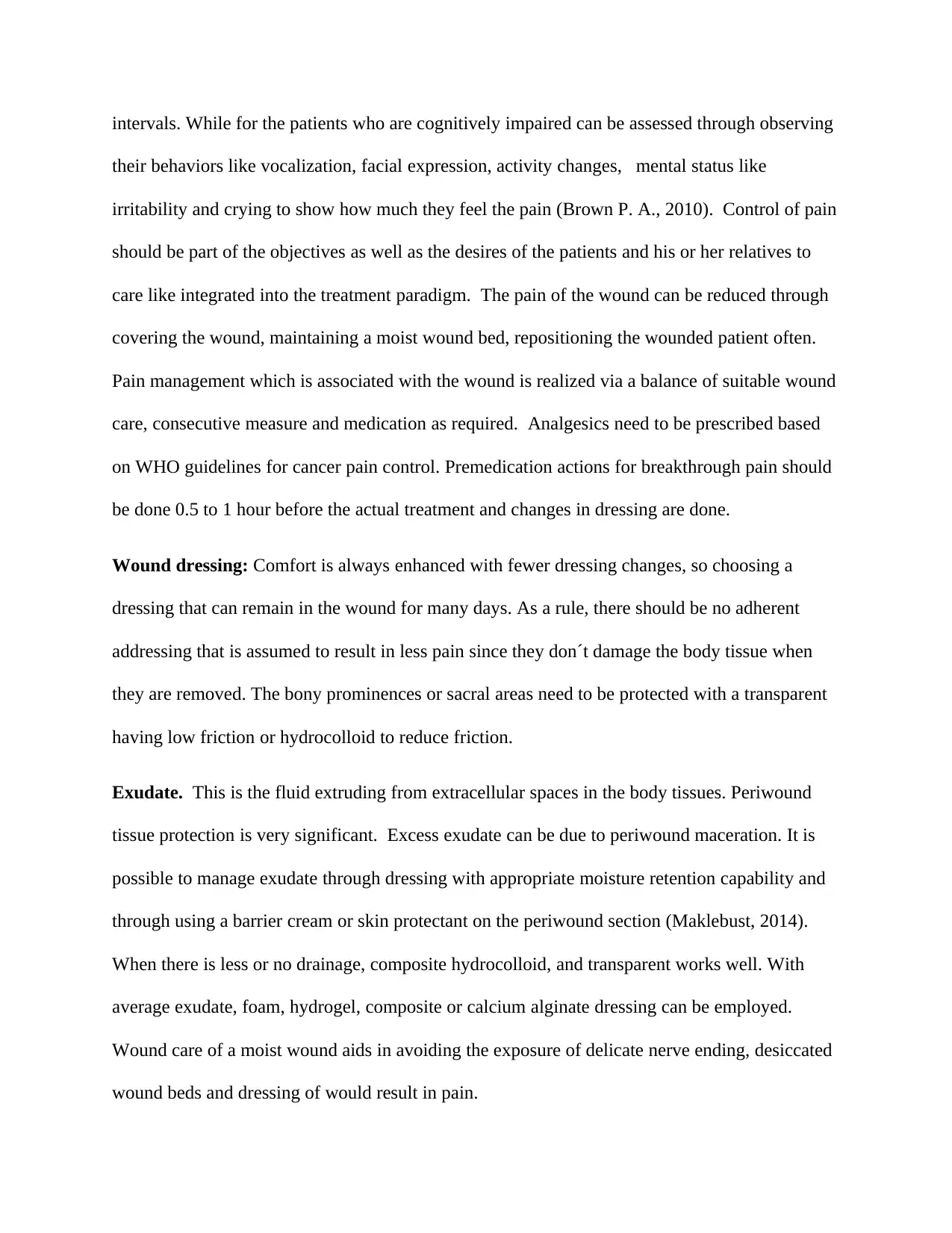
intervals. While for the patients who are cognitively impaired can be assessed through observing
their behaviors like vocalization, facial expression, activity changes, mental status like
irritability and crying to show how much they feel the pain (Brown P. A., 2010). Control of pain
should be part of the objectives as well as the desires of the patients and his or her relatives to
care like integrated into the treatment paradigm. The pain of the wound can be reduced through
covering the wound, maintaining a moist wound bed, repositioning the wounded patient often.
Pain management which is associated with the wound is realized via a balance of suitable wound
care, consecutive measure and medication as required. Analgesics need to be prescribed based
on WHO guidelines for cancer pain control. Premedication actions for breakthrough pain should
be done 0.5 to 1 hour before the actual treatment and changes in dressing are done.
Wound dressing: Comfort is always enhanced with fewer dressing changes, so choosing a
dressing that can remain in the wound for many days. As a rule, there should be no adherent
addressing that is assumed to result in less pain since they don´t damage the body tissue when
they are removed. The bony prominences or sacral areas need to be protected with a transparent
having low friction or hydrocolloid to reduce friction.
Exudate. This is the fluid extruding from extracellular spaces in the body tissues. Periwound
tissue protection is very significant. Excess exudate can be due to periwound maceration. It is
possible to manage exudate through dressing with appropriate moisture retention capability and
through using a barrier cream or skin protectant on the periwound section (Maklebust, 2014).
When there is less or no drainage, composite hydrocolloid, and transparent works well. With
average exudate, foam, hydrogel, composite or calcium alginate dressing can be employed.
Wound care of a moist wound aids in avoiding the exposure of delicate nerve ending, desiccated
wound beds and dressing of would result in pain.
their behaviors like vocalization, facial expression, activity changes, mental status like
irritability and crying to show how much they feel the pain (Brown P. A., 2010). Control of pain
should be part of the objectives as well as the desires of the patients and his or her relatives to
care like integrated into the treatment paradigm. The pain of the wound can be reduced through
covering the wound, maintaining a moist wound bed, repositioning the wounded patient often.
Pain management which is associated with the wound is realized via a balance of suitable wound
care, consecutive measure and medication as required. Analgesics need to be prescribed based
on WHO guidelines for cancer pain control. Premedication actions for breakthrough pain should
be done 0.5 to 1 hour before the actual treatment and changes in dressing are done.
Wound dressing: Comfort is always enhanced with fewer dressing changes, so choosing a
dressing that can remain in the wound for many days. As a rule, there should be no adherent
addressing that is assumed to result in less pain since they don´t damage the body tissue when
they are removed. The bony prominences or sacral areas need to be protected with a transparent
having low friction or hydrocolloid to reduce friction.
Exudate. This is the fluid extruding from extracellular spaces in the body tissues. Periwound
tissue protection is very significant. Excess exudate can be due to periwound maceration. It is
possible to manage exudate through dressing with appropriate moisture retention capability and
through using a barrier cream or skin protectant on the periwound section (Maklebust, 2014).
When there is less or no drainage, composite hydrocolloid, and transparent works well. With
average exudate, foam, hydrogel, composite or calcium alginate dressing can be employed.
Wound care of a moist wound aids in avoiding the exposure of delicate nerve ending, desiccated
wound beds and dressing of would result in pain.
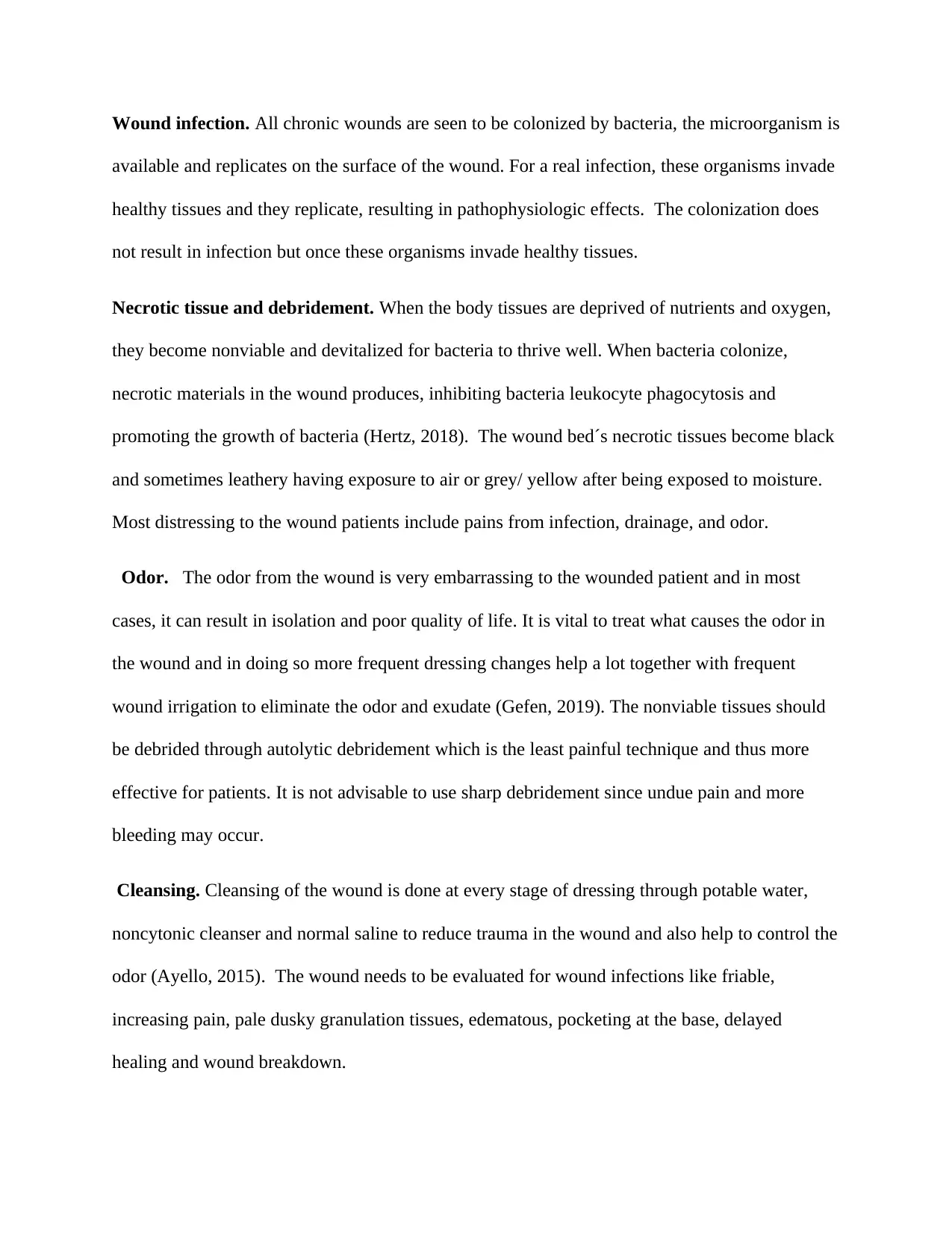
Wound infection. All chronic wounds are seen to be colonized by bacteria, the microorganism is
available and replicates on the surface of the wound. For a real infection, these organisms invade
healthy tissues and they replicate, resulting in pathophysiologic effects. The colonization does
not result in infection but once these organisms invade healthy tissues.
Necrotic tissue and debridement. When the body tissues are deprived of nutrients and oxygen,
they become nonviable and devitalized for bacteria to thrive well. When bacteria colonize,
necrotic materials in the wound produces, inhibiting bacteria leukocyte phagocytosis and
promoting the growth of bacteria (Hertz, 2018). The wound bed´s necrotic tissues become black
and sometimes leathery having exposure to air or grey/ yellow after being exposed to moisture.
Most distressing to the wound patients include pains from infection, drainage, and odor.
Odor. The odor from the wound is very embarrassing to the wounded patient and in most
cases, it can result in isolation and poor quality of life. It is vital to treat what causes the odor in
the wound and in doing so more frequent dressing changes help a lot together with frequent
wound irrigation to eliminate the odor and exudate (Gefen, 2019). The nonviable tissues should
be debrided through autolytic debridement which is the least painful technique and thus more
effective for patients. It is not advisable to use sharp debridement since undue pain and more
bleeding may occur.
Cleansing. Cleansing of the wound is done at every stage of dressing through potable water,
noncytonic cleanser and normal saline to reduce trauma in the wound and also help to control the
odor (Ayello, 2015). The wound needs to be evaluated for wound infections like friable,
increasing pain, pale dusky granulation tissues, edematous, pocketing at the base, delayed
healing and wound breakdown.
available and replicates on the surface of the wound. For a real infection, these organisms invade
healthy tissues and they replicate, resulting in pathophysiologic effects. The colonization does
not result in infection but once these organisms invade healthy tissues.
Necrotic tissue and debridement. When the body tissues are deprived of nutrients and oxygen,
they become nonviable and devitalized for bacteria to thrive well. When bacteria colonize,
necrotic materials in the wound produces, inhibiting bacteria leukocyte phagocytosis and
promoting the growth of bacteria (Hertz, 2018). The wound bed´s necrotic tissues become black
and sometimes leathery having exposure to air or grey/ yellow after being exposed to moisture.
Most distressing to the wound patients include pains from infection, drainage, and odor.
Odor. The odor from the wound is very embarrassing to the wounded patient and in most
cases, it can result in isolation and poor quality of life. It is vital to treat what causes the odor in
the wound and in doing so more frequent dressing changes help a lot together with frequent
wound irrigation to eliminate the odor and exudate (Gefen, 2019). The nonviable tissues should
be debrided through autolytic debridement which is the least painful technique and thus more
effective for patients. It is not advisable to use sharp debridement since undue pain and more
bleeding may occur.
Cleansing. Cleansing of the wound is done at every stage of dressing through potable water,
noncytonic cleanser and normal saline to reduce trauma in the wound and also help to control the
odor (Ayello, 2015). The wound needs to be evaluated for wound infections like friable,
increasing pain, pale dusky granulation tissues, edematous, pocketing at the base, delayed
healing and wound breakdown.
⊘ This is a preview!⊘
Do you want full access?
Subscribe today to unlock all pages.

Trusted by 1+ million students worldwide

Nutrition. The patient might consume food with very little fluid. From the guidelines of
NPUAP –EPUAP, it is significant to address nutrition as well as the needs of the hydration in the
meals so that the patient takes in the required meal with the right fluid (Thomas, 2012). Having
so many small meals a day, nutritional protein and a liberal diet supplement when the wound is
healing is the healing goal which is highly recommended.
References
Ayello, E. (2015). Wound Care Essentials: Practice Principles. Tokyo: Wolters Kluwer Health. Retrieved
from https://books.google.co.ke/books?
id=BltECgAAQBAJ&dq=wound+care+prevention&hl=en&sa=X&ved=0ahUKEwjS_puEvODnAhUYA
WMBHVchB4cQ6AEILzAB
Baranoski, S. (2013). Wound Care Essentials: Practice Principles. Liverpool: Lippincott Williams & Wilkins.
Retrieved from https://books.google.co.ke/books?
id=qxMXba1uRHkC&dq=wound+care+prevention&source=gbs_navlinks_s
Brown, P. (2012). Quick Reference to Wound Care: Palliative, Home, and Clinical Practices. Liverpool:
Jones & Bartlett Publishers. Retrieved from https://books.google.co.ke/books?
id=6DvFwaXCt0wC&dq=wound+care+prevention&source=gbs_navlinks_s
Brown, P. A. (2010). Quick Reference to Wound Care: Palliative, Home, and Clinical Practices. Hull: Jones
& Bartlett Publishers. Retrieved from https://books.google.co.ke/books?
id=VmfD7ET3CY4C&dq=wound+care+prevention&source=gbs_navlinks_s
Flanagan, M. (2013). Wound Healing and Skin Integrity: Principles and Practice. London: John Wiley &
Sons. Retrieved from https://books.google.co.ke/books?
id=0VqhGoN8HD0C&dq=wound+care+prevention&source=gbs_navlinks_s
Gefen, A. (2019). Innovations and Emerging Technologies in Wound Care. Amsterdam: Elsevier.
Retrieved from https://books.google.co.ke/books?
id=sMe3DwAAQBAJ&dq=wound+care+prevention&source=gbs_navlinks_s
NPUAP –EPUAP, it is significant to address nutrition as well as the needs of the hydration in the
meals so that the patient takes in the required meal with the right fluid (Thomas, 2012). Having
so many small meals a day, nutritional protein and a liberal diet supplement when the wound is
healing is the healing goal which is highly recommended.
References
Ayello, E. (2015). Wound Care Essentials: Practice Principles. Tokyo: Wolters Kluwer Health. Retrieved
from https://books.google.co.ke/books?
id=BltECgAAQBAJ&dq=wound+care+prevention&hl=en&sa=X&ved=0ahUKEwjS_puEvODnAhUYA
WMBHVchB4cQ6AEILzAB
Baranoski, S. (2013). Wound Care Essentials: Practice Principles. Liverpool: Lippincott Williams & Wilkins.
Retrieved from https://books.google.co.ke/books?
id=qxMXba1uRHkC&dq=wound+care+prevention&source=gbs_navlinks_s
Brown, P. (2012). Quick Reference to Wound Care: Palliative, Home, and Clinical Practices. Liverpool:
Jones & Bartlett Publishers. Retrieved from https://books.google.co.ke/books?
id=6DvFwaXCt0wC&dq=wound+care+prevention&source=gbs_navlinks_s
Brown, P. A. (2010). Quick Reference to Wound Care: Palliative, Home, and Clinical Practices. Hull: Jones
& Bartlett Publishers. Retrieved from https://books.google.co.ke/books?
id=VmfD7ET3CY4C&dq=wound+care+prevention&source=gbs_navlinks_s
Flanagan, M. (2013). Wound Healing and Skin Integrity: Principles and Practice. London: John Wiley &
Sons. Retrieved from https://books.google.co.ke/books?
id=0VqhGoN8HD0C&dq=wound+care+prevention&source=gbs_navlinks_s
Gefen, A. (2019). Innovations and Emerging Technologies in Wound Care. Amsterdam: Elsevier.
Retrieved from https://books.google.co.ke/books?
id=sMe3DwAAQBAJ&dq=wound+care+prevention&source=gbs_navlinks_s
Paraphrase This Document
Need a fresh take? Get an instant paraphrase of this document with our AI Paraphraser
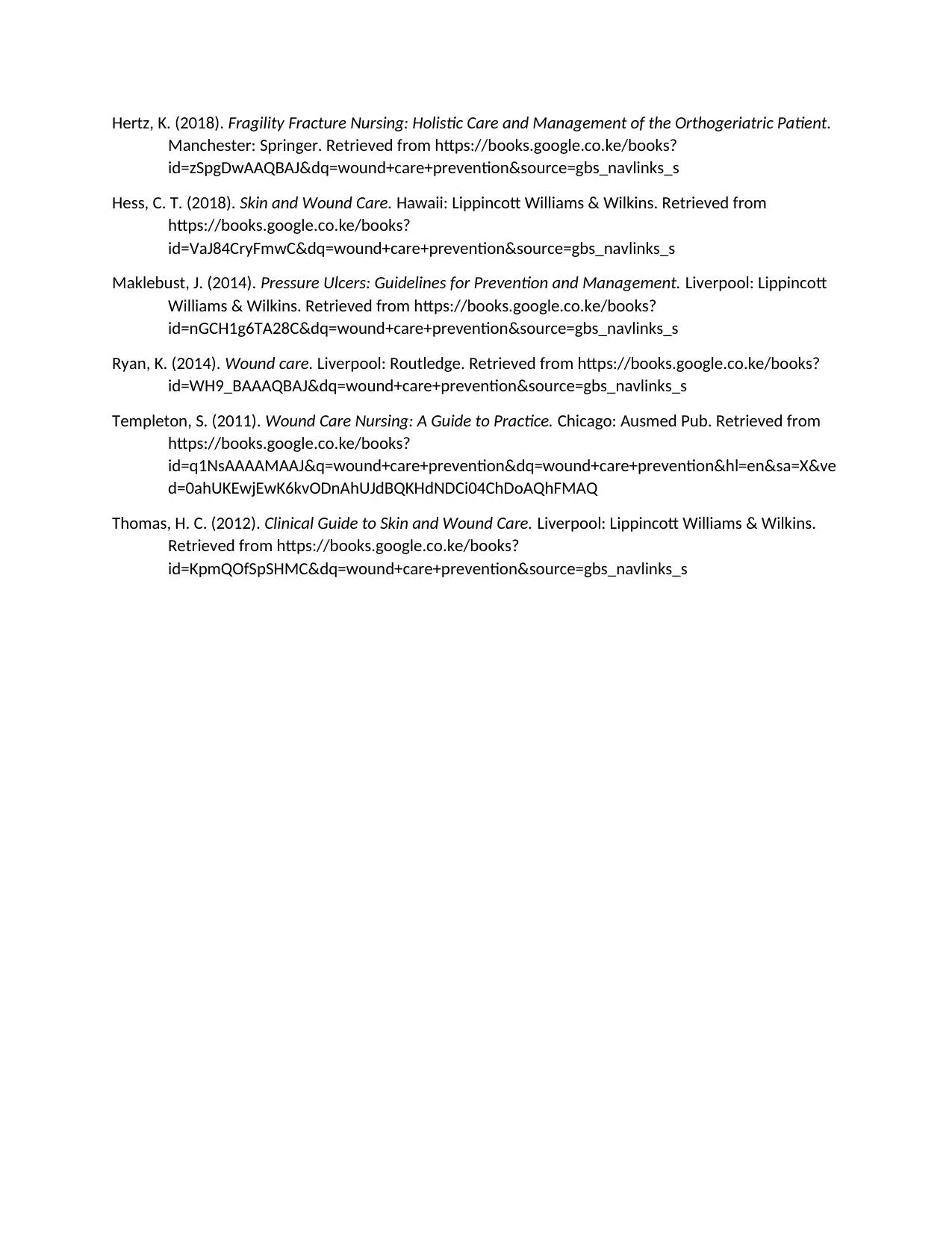
Hertz, K. (2018). Fragility Fracture Nursing: Holistic Care and Management of the Orthogeriatric Patient.
Manchester: Springer. Retrieved from https://books.google.co.ke/books?
id=zSpgDwAAQBAJ&dq=wound+care+prevention&source=gbs_navlinks_s
Hess, C. T. (2018). Skin and Wound Care. Hawaii: Lippincott Williams & Wilkins. Retrieved from
https://books.google.co.ke/books?
id=VaJ84CryFmwC&dq=wound+care+prevention&source=gbs_navlinks_s
Maklebust, J. (2014). Pressure Ulcers: Guidelines for Prevention and Management. Liverpool: Lippincott
Williams & Wilkins. Retrieved from https://books.google.co.ke/books?
id=nGCH1g6TA28C&dq=wound+care+prevention&source=gbs_navlinks_s
Ryan, K. (2014). Wound care. Liverpool: Routledge. Retrieved from https://books.google.co.ke/books?
id=WH9_BAAAQBAJ&dq=wound+care+prevention&source=gbs_navlinks_s
Templeton, S. (2011). Wound Care Nursing: A Guide to Practice. Chicago: Ausmed Pub. Retrieved from
https://books.google.co.ke/books?
id=q1NsAAAAMAAJ&q=wound+care+prevention&dq=wound+care+prevention&hl=en&sa=X&ve
d=0ahUKEwjEwK6kvODnAhUJdBQKHdNDCi04ChDoAQhFMAQ
Thomas, H. C. (2012). Clinical Guide to Skin and Wound Care. Liverpool: Lippincott Williams & Wilkins.
Retrieved from https://books.google.co.ke/books?
id=KpmQOfSpSHMC&dq=wound+care+prevention&source=gbs_navlinks_s
Manchester: Springer. Retrieved from https://books.google.co.ke/books?
id=zSpgDwAAQBAJ&dq=wound+care+prevention&source=gbs_navlinks_s
Hess, C. T. (2018). Skin and Wound Care. Hawaii: Lippincott Williams & Wilkins. Retrieved from
https://books.google.co.ke/books?
id=VaJ84CryFmwC&dq=wound+care+prevention&source=gbs_navlinks_s
Maklebust, J. (2014). Pressure Ulcers: Guidelines for Prevention and Management. Liverpool: Lippincott
Williams & Wilkins. Retrieved from https://books.google.co.ke/books?
id=nGCH1g6TA28C&dq=wound+care+prevention&source=gbs_navlinks_s
Ryan, K. (2014). Wound care. Liverpool: Routledge. Retrieved from https://books.google.co.ke/books?
id=WH9_BAAAQBAJ&dq=wound+care+prevention&source=gbs_navlinks_s
Templeton, S. (2011). Wound Care Nursing: A Guide to Practice. Chicago: Ausmed Pub. Retrieved from
https://books.google.co.ke/books?
id=q1NsAAAAMAAJ&q=wound+care+prevention&dq=wound+care+prevention&hl=en&sa=X&ve
d=0ahUKEwjEwK6kvODnAhUJdBQKHdNDCi04ChDoAQhFMAQ
Thomas, H. C. (2012). Clinical Guide to Skin and Wound Care. Liverpool: Lippincott Williams & Wilkins.
Retrieved from https://books.google.co.ke/books?
id=KpmQOfSpSHMC&dq=wound+care+prevention&source=gbs_navlinks_s
1 out of 8
Related Documents
Your All-in-One AI-Powered Toolkit for Academic Success.
+13062052269
info@desklib.com
Available 24*7 on WhatsApp / Email
![[object Object]](/_next/static/media/star-bottom.7253800d.svg)
Unlock your academic potential
Copyright © 2020–2025 A2Z Services. All Rights Reserved. Developed and managed by ZUCOL.





